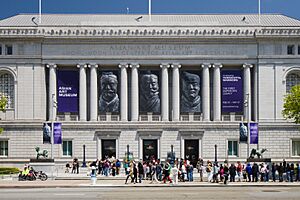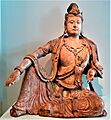Asian Art Museum (San Francisco) facts for kids
 |
|
 |
|
| Lua error in Module:Location_map at line 420: attempt to index field 'wikibase' (a nil value). | |
| Established | 1966 |
|---|---|
| Type | Asian art |
| Architect | Building (1917): George Kelham Museum interior (2003): Gae Aulenti |
| Area | 185,000-square-foot (17,200 m2) |
The Asian Art Museum of San Francisco is a special place in San Francisco, California. It focuses on Asian art from many different countries. This museum was started in the 1960s by Olympian Avery Brundage.
It has over 18,000 pieces of art in its main collection. Some of these artworks are super old, up to 6,000 years! The museum's logo looks like an upside-down letter "A". It also looks like a "V" with a line through it.
Contents
History of the Museum
The museum began with a big gift from Avery Brundage. He was a rich collector from Chicago who loved Asian art. A group called the Society for Asian Art formed in 1958 to get his collection.
The museum first opened in 1966. It was a part of the M. H. de Young Memorial Museum in Golden Gate Park. Brundage kept giving art to the museum. When he passed away in 1975, he left all his remaining Asian art to San Francisco. In total, he gave more than 7,700 art pieces.
Avery Brundage said he wanted to create a "bridge of understanding" between the U.S. and Asia. However, his actions showed he had some unfair beliefs. These beliefs went against the museum's goals of bringing people together. In 2020, the museum removed a statue of Brundage from its lobby. It had been there for 50 years. The museum also started looking closely at his past. The museum director, Jay Xu, said that Brundage had "racist and anti-Semitic views."
On December 1, 2020, the museum received a special award. The Japanese Foreign Minister gave them a Commendation. This was for helping to share Japanese and American culture through art. Jay Xu is the museum's current director.
Moving to a New Home
Until 2003, the museum shared its building with the de Young Museum. This was in Golden Gate Park. But the museum's collection grew too big. The old building wasn't large enough to show or even store all the art.
In 1987, Mayor Dianne Feinstein suggested a plan. She wanted to improve the Civic Center area. Part of her plan was to move the museum to the old Main Library building. In 1995, a businessman from Silicon Valley, Chong-Moon Lee, gave $15 million. This big donation helped start the fundraising for the new building.
The museum closed for a year to move to its new spot. It reopened on March 20, 2003. The new location is across from the San Francisco Civic Center. The old library building was updated for the museum. Italian architect Gae Aulenti led this renovation.
The old Main Library was a beautiful Beaux Arts-style building. It was designed by George Kelham in 1917. The new project cost $160.5 million. Gae Aulenti's design added a bright, open court inside. This court became a dramatic center for the museum. She removed some inner walls to make it feel more open. This also made it easier for visitors to move around and see the art. The new museum is 185,000-square-foot (17,200 m2) big. This means it has about 75 percent more space for exhibits than the old location.
The renovation also made the building safer from earthquakes. Special "base isolation" parts were added under the building. These help the building move safely during an earthquake. Strong concrete walls were also added. This makes the building very stable.
In October 2011, the museum got a new look for its brand. A company called Wolff Olins designed the new logo. It's an upside-down "A." This represents looking at Asian art in a fresh, new way.
Growing Bigger
In March 2016, the museum announced more plans. They would build an extra new section. This new part will be on top of an existing lower wing. It will add about 9,000 square feet of new space. This expansion was expected to open by September 2019. In January 2019, Abby Chen became the Head of Contemporary Art.
Amazing Art Collection
The museum has about 18,000 works of art and old objects. These come from all the main Asian countries and cultures. Some pieces are as old as 6,000 years!
There are special rooms, called galleries, for art from different places. You can see art from South Asia, Iran and Central Asia, Southeast Asia, the Himalayas, China, Korea, and Japan. More than 2,000 artworks are on display in the museum's galleries.
The museum often hosts special and traveling exhibits. In 1975, it had the first big Chinese exhibit to leave China after World War II. Another exhibit about old archaeological finds brought 800,000 visitors in eight weeks. In 1991, an exhibit about wisdom and kindness was opened by the Dalai Lama.
Collection Highlights
-
Bronze zun shaped like a rhinoceros. From the Shang dynasty, around 1100-1050 BCE.
-
The god Indra (Taishakuten), one of two statues. From Nara, around 730-750 AD.
-
The bodhisattva Avalokiteshvara (Guanyin). From the Song dynasty, 12th century.
-
A beautiful ewer (a type of pitcher) with a lotus-shaped lid. From Goryeo, around 1050-1150 AD.
Japanese Tea House
You can find a Japanese tea house on the second floor of the museum. This special house was first built in Kyoto, Japan. Then, it was taken apart, shipped to San Francisco, and put back together inside the museum by Japanese carpenters.
The tea house has a name, "In the Mist." You can see this name on a wooden sign next to it. The writing on the sign is based on the calligraphy by Yamada Sobin. Yoshiko Kakudo, the museum's first Japanese art curator, asked for it to be made.
Architect Osamu Sato designed the Tea House. It works as a real tea house and also as a display. It's a three and three-quarters mat room. It has a special space for a scroll and flowers. There's also an electric-powered sunken hearth for a hot water kettle in winter. Plus, it has a working area with fresh running water and a drain.
See also
 In Spanish: Museo de Arte Asiático de San Francisco para niños
In Spanish: Museo de Arte Asiático de San Francisco para niños
- 49-Mile Scenic Drive
- List of museums with major collections of Asian art









